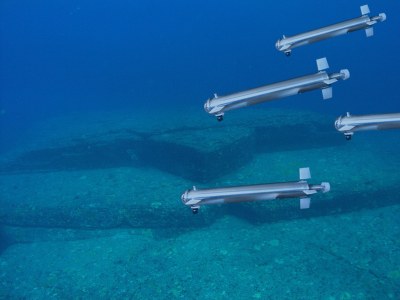Innovation Technology: Robotic fish to protect Venice from rising waters
22/10/2015
This new technology was presented at the Venice EXPO during the Conference “Communication technologies for the protection of marine and inland water: research and topicality” organized by the Directorate-General for Electronic Communication Broadcasting and Postal Service of the Ministry of Economic Development in collaboration with Linkem and attended, among others, by ENEA, Rome’s University of Tor Vergata, ISPRA and the Italian Corps of Port Captaincies.
“Venus is the basic element of a swarm system composed of several cooperative and coordinated vehicles and it’s the result of years of studies carried out in our Robotics Laboratories – Vincenzo Nanni of ENEA says- a line of research focused on mimicking aggregation patterns in animals and their collective intelligence”.
 This robotic formation is called “ high-density swarm” and deploys tens of drones adjacent to one another, in contrast to the current systems in which robots are hundreds of meters away from each other.
This robotic formation is called “ high-density swarm” and deploys tens of drones adjacent to one another, in contrast to the current systems in which robots are hundreds of meters away from each other.
Each robot is made up of a submarine wireless system that uses sound and light to communicate: the optical system makes it possible to transmit a large amount of information but only in very clean waters and at short distances while the sound system, specifically redesigned, has a lower performance but can be employed in “dirty” waters.
An innovative and multichannel sound-light modem is to be mounted on board Venus swarm robots, using the synergy between the channels utilized and the short distance. Thanks to the hybrid technology employed data can be transmitted at rates of several megabits per second, obtaining a major improvement compared to the current possibilities.
ENEA and Tor Vergata plan to create in the future a marine digital highway with the implementation of a hybrid communication system:
The use of robotic fish to monitor and survey coastal and ocean sea beds offers great advantages compared to individual and sophisticated robots which are very expensive.
A lot of work awaits the swarms, first of all with the surveillance of marine structures such as oil platforms, gas pipelines and ports that could be vulnerable to sabotage and terrorist attacks.
Currently, seaport protection is mainly based on above water security systems while the new ENEA technology can detect underwater threats. Drones could also provide critical support to migrant rescue operations at sea.
But there’s more.
These high-tech swimmers could be employed to protect marine biodiversity, monitor pollution levels and detect archaeological remains on the seabed.
ENEA and the Rome’s University Tor Vergata are working on a European project on marine life and human nutrition based on the study of the interaction between robotic systems and shoals of fish, aimed at improving the health condition and welfare of fish farming.
For more information please contact:
Claudio Moriconi, ENEA Casaccia Research Center, claudio.moriconi@enea.it
